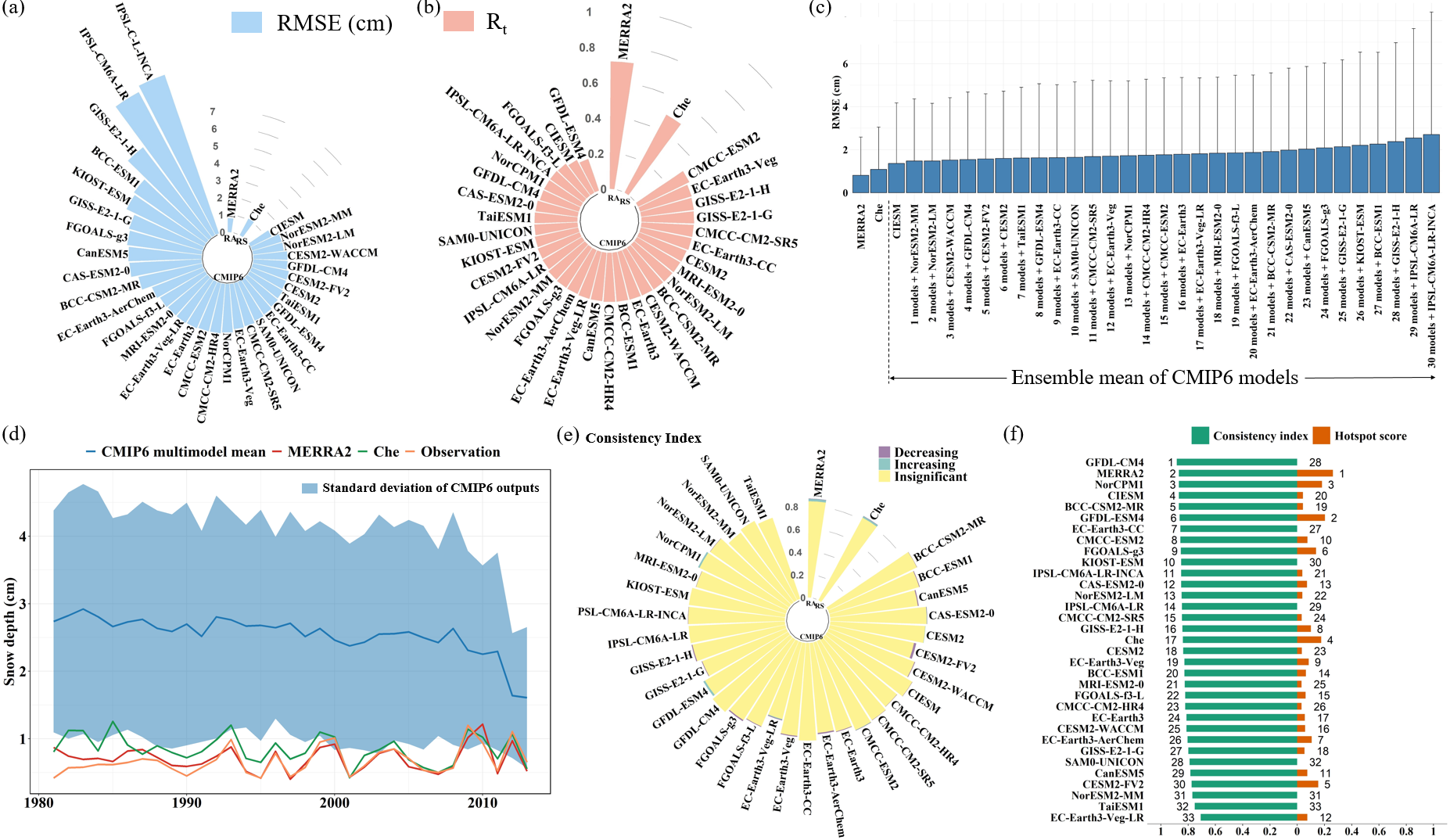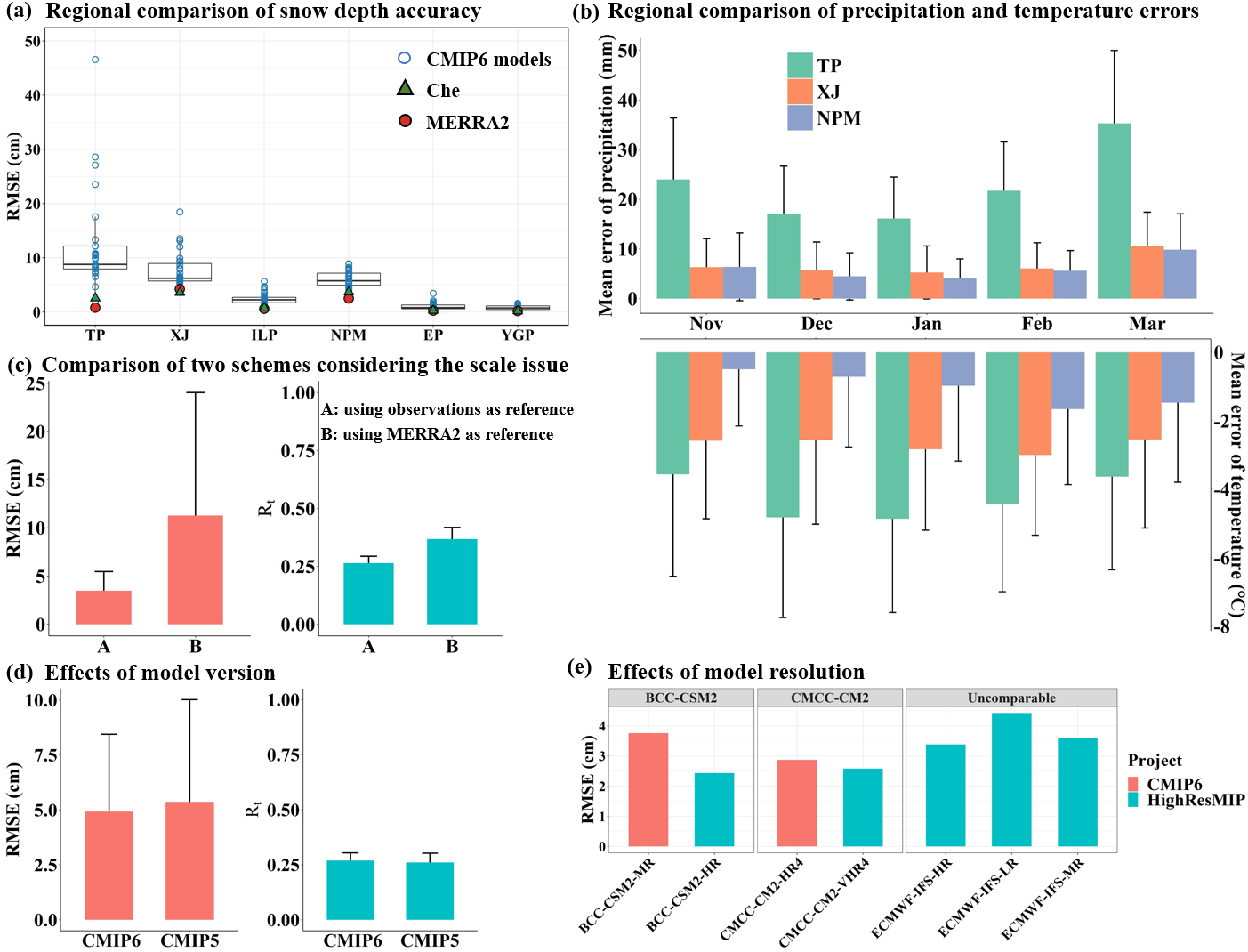Snow greatly affects agricultural water availability in global mountainous regions. Snow changes under climatic warming may create risks for the safety of regional agricultural water resources. The global climate models of the Coupled Model Intercomparison Project Phase 6 (CMIP6) are important tools for predicting and evaluating future snow changes. However, snow simulations from CMIP6 models have not been well evaluated in terms of temporal change and mountain snow, with major error sources remaining unclear.
For overcoming this problem, the Environmental Change and Multi-sphere Processes Group from Institute of Tibetan Plateau Research, Chinese Academy of Sciences (ITPCAS) have recently synthetically used long-term station observations, reanalysis (MERRA2), and remote sensing data (referred to as “Che”) to evaluate snow depth simulations of 31 state-of-the-art CMIP6 models in both the high mountain Tibetan Plateau and other areas of China, and analyzed major sources of error based on regression models of snow depth errors. In addition, a new evaluation metric (referred to as “Hotspot score”) was proposed to evaluate performances of CMIP6 models more efficiently in predicting significant trends of snow depth change. The results show that:
All the CMIP6 models showed larger root-mean-square error (RMSE) and lower temporal correlation coefficient (Rt) of snow depth than both MERRA2 and Che (Fig. 1a-b). Compared with the best CMIP6 model (i.e., CIESM), an ensemble mean of multiple CMIP6 models cannot produce a lower RMSD of snow depth (Fig. 1c).

Figure 1. Accuracy comparison of 31 CMIP6 models, reanalysis (RA) and remote sensing (RS) datasets in terms of RMSE (a), temporal R (Rt) (b), overall trend (d), Consistency index (e), and Hotspot score (f). Panel (c) shows the comparison of RMSE from the ensemble mean of 31 combinations of CMIP6 models and the x-axis ordered by RMSE.
Hotspot score can effectively distinguish the performance differences of different models/datasets in simulating significant snow depth trends, and the Hotspot scores of all CMIP6 models are significantly lower than MERRA2 reanalysis data (Fig. 1d-f). In addition, the snow depth errors (RMSE) of CMIP6 models in the Tibetan Plateau are significantly higher than those in the other regions of China. However, such phenomenon does not exist in the regional comparison results of the MERRA2 and Che datasets (Fig. 2a).

Figure 2. Regional comparison of snow depth accuracy (a) and effects on evaluation results from other factors including the scale issue (c), model version (d) and model resolution (e). Panel (b) shows the regional comparison of mean errors of precipitation and temperature for CMIP6 models. TP: Tibetan Plateau; XJ: Xinjiang; ILP: Inner Mongolia and Loess Plateau; NPM: northeastern plain and mountain; EP: eastern plain; YGP: Yunnan and Guizhou Plateau.
Precipitation and temperature errors are the main causes of the large snow depth errors of CMIP6 models in China, and the accumulated errors in the prior months have important impacts: The adjusted R-squared of the snow depth error regression model considering the precipitation and temperature errors of both the current and prior months is significantly higher than that of the regression model considering only the current month, and the grid average adjusted R-squared of the former regression model is more than 65% in China (Fig. 3a-b). Thus, CMIP6 models have larger snow depth errors in the Tibetan Plateau mainly due to more serious wet bias and cooling bias than other regions (Fig. 2b).
In NPM and XJ which had the highest values of snow depth in China, most of CMIP6 models postponed the peak month of SD from January to February (or even March) (Figs. 3c-d). Such time lags were also observed by a previous study who reported a two-month delay in the seasonal maximum SD in the CMIP6 models over Arctic Sea Ice, but did not address the causes. Here, we found that the time lag was mainly caused by the accumulated errors of precipitation and temperature of prior months (Fig. 3e).

Figure 3. Error attribution for the poor performance of CMIP6 models in simulating temporal changes of snow depth (SD). Panel (a) the spatial distributions of 31-model mean proportions of SD errors of winter months explained by the regression models M1 and M2; Panel (b) comparison of four regression models of error attribution considering the accumulated effects of precipitation (P) and temperature (T) errors in prior months; Panels (c) and (d) show the effects of accumulated errors of P and T in prior months on the time lag of the peak SD month in NPM and XJ, respectively. In panel (e), “R of P/T” means the correlation between SD errors of peak month and precipitation/temperature errors.
The above findings were recently published in Geophysical Research Letters with the title of “Why do CMIP6 Models Fail to simulate snow depth in terms of temporal change and high mountain snow of China Skillfully?” The corresponding author of this paper is Professor Fan Zhang of ITPCAS, and the first author is Dr. Hongbo Zhang (now associate Professor of China Agricultural University), who graduated from ITPCAS. This research was supported by the Shandong Provincial Natural Science Foundation (ZR2021MD029) and the National Natural Science Foundation of China (42125104 and 41701079).
Citation:Zhang, H., Zhang, F.*, Zhang, G., Yan, W. (2022). Why do CMIP6 models fail to simulate snow depth in terms of temporal change and high mountain snow of China skillfully? Geophysical Research Letters, 49(15), e2022GL098888


